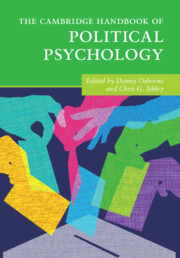Book contents
- The Cambridge Handbook of Political Psychology
- The Cambridge Handbook of Political Psychology
- Copyright page
- Dedication
- Contents
- Figures
- Tables
- Contributors
- Part I Foundations of Political Psychology
- Part II The Politics of Intergroup Attitudes
- 11 Authoritarianism
- 12 A Political Psychology of Ethnocentrism
- 13 Collective Narcissism
- 14 Demographic Change, White Decline, and the Changing Nature of Racial Politics in Election Campaigns
- 15 Macro-diversity and Intergroup Attitudes
- 16 The Persistence of Gender in Campaigns and Elections
- 17 The Politics of Abortion, Pregnancy, and Motherhood
- 18 Religiosity and Openness to Authoritarian Governance
- 19 The Consequences of Moral Conviction in Politics
- 20 The Political Psychology of National Identity
- 21 The Political Dynamics of Immigration Opinion Worldwide
- 22 International and Individual Differences in Support for Human Rights
- Part III Contemporary Challenges to Democracy
- Part IV Diversifying Perspectives in Political Psychology
- Index
- References
15 - Macro-diversity and Intergroup Attitudes
from Part II - The Politics of Intergroup Attitudes
Published online by Cambridge University Press: 17 February 2022
- The Cambridge Handbook of Political Psychology
- The Cambridge Handbook of Political Psychology
- Copyright page
- Dedication
- Contents
- Figures
- Tables
- Contributors
- Part I Foundations of Political Psychology
- Part II The Politics of Intergroup Attitudes
- 11 Authoritarianism
- 12 A Political Psychology of Ethnocentrism
- 13 Collective Narcissism
- 14 Demographic Change, White Decline, and the Changing Nature of Racial Politics in Election Campaigns
- 15 Macro-diversity and Intergroup Attitudes
- 16 The Persistence of Gender in Campaigns and Elections
- 17 The Politics of Abortion, Pregnancy, and Motherhood
- 18 Religiosity and Openness to Authoritarian Governance
- 19 The Consequences of Moral Conviction in Politics
- 20 The Political Psychology of National Identity
- 21 The Political Dynamics of Immigration Opinion Worldwide
- 22 International and Individual Differences in Support for Human Rights
- Part III Contemporary Challenges to Democracy
- Part IV Diversifying Perspectives in Political Psychology
- Index
- References
Summary
Many Western societies are becoming increasingly ethnically diverse. In this chapter, we focus on whether diversity at a macro level (that is, diversity of individuals’ social contexts) is beneficial or disadvantageous for intergroup relations. We therefore review research in political and social psychology on the consequences of macro-diversity for majority members of the host societies, looking at social trust, intergroup attitudes, and political behaviour as the main outcome variables. First, we start by conceptualising macro-level diversity and outlining some methodological considerations. Next, we briefly review the evidence on the question whether ethnic diversity has positive or negative consequences for intergroup relations. We then focus on two potential psychological mechanisms explaining effects of increased macro-diversity on individual outcomes: perception of threat versus intergroup contact. Moreover, we discuss individual and contextual moderators of the relation between ethnic diversity and intergroup attitudes. Finally, we end this chapter by outlining future directions for research.
- Type
- Chapter
- Information
- The Cambridge Handbook of Political Psychology , pp. 243 - 257Publisher: Cambridge University PressPrint publication year: 2022
References
- 2
- Cited by



